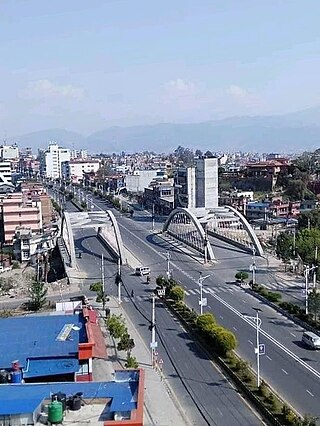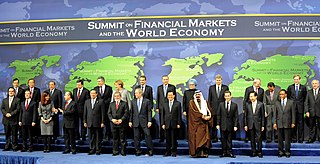Rankings
|
|
|
The Asia Power Index is an index that measures resources and influence to rank the relative power of states in Indo-Pacific, published by the Lowy Institute annually from 2018. The Index ranks 26 countries and territories. [1]
The index evaluates international power in Asia through 128 indicators across eight thematic measures: [2] Eight thematic measures are as follows: (Percent in parentheses indicates weighting)
|
|
|

Gross domestic product (GDP) is a monetary measure of the market value of all the final goods and services produced in a specific time period by a country or countries. GDP is more often used by the government of a single country to measure its economic health. Due to its complex and subjective nature, this measure is often revised before being considered a reliable indicator.

The economy of Nepal is developing category and largely dependent on agriculture and remittances. Until the mid-20th century Nepal was an isolated pre-industrial society, which entered the modern era in 1951 without schools, hospitals, roads, telecommunications, electric power, industry, or civil service. The country has, however, made progress toward sustainable economic growth since the 1950s. The country was opened to economic liberalization, leading to economic growth and improvement in living standards when compared to the past. The biggest challenges faced by the country in achieving higher economic development are the frequent changes in political leadership, as well as corruption.

The economy of the Philippines is an emerging market, and considered as a newly industrialized country in the Asia-Pacific region. In 2023, the Philippine economy is estimated to be at ₱25.27 trillion, making it the world's 34th largest by nominal GDP and 14th largest in Asia according to the International Monetary Fund.

The Association of Southeast Asian Nations, commonly as ASEAN, is a political and economic union of 10 states in Southeast Asia. Together, its member states represent a population of over 600 million over a land area of 4.5 million km2 (1.7 million sq mi). The bloc generated a purchasing power parity (PPP) gross domestic product (GDP) of around US$10.2 trillion in 2022, constituting approximately 6.5% of global GDP (PPP). ASEAN member states include some of the fastest growing economies in the world.
In politics, soft power is the ability to co-opt rather than coerce. It involves shaping the preferences of others through appeal and attraction. Soft power is non-coercive, using culture, political values, and foreign policies to enact change. In 2012, Joseph Nye of Harvard University explained that with soft power, "the best propaganda is not propaganda", further explaining that during the Information Age, "credibility is the scarcest resource".
In international relations, power is defined in several different ways. Material definitions of state power emphasize economic and military power. Other definitions of power emphasize the ability to structure and constitute the nature of social relations between actors. Power is an attribute of particular actors in their interactions, as well as a social process that constitutes the social identities and capacities of actors.

In international relations, a middle power is a sovereign state that is not a great power nor a superpower, but still has large or moderate influence and international recognition.

In international relations, regional power, since the late 20th century has been used for a sovereign state that exercises significant power within a given geographical region. States that wield unrivaled power and influence within a region of the world possess regional hegemony.

A global city, also known as a power city, world city, alpha city, or world center, is a city that serves as a primary node in the global economic network. The concept originates from geography and urban studies, based on the thesis that globalization has created a hierarchy of strategic geographic locations with varying degrees of influence over finance, trade, and culture worldwide. The global city represents the most complex and significant hub within the international system, characterized by links binding it to other cities that have direct, tangible effects on global socioeconomic affairs.
Comprehensive National Power (CNP) is a measure of the general power of a nation-state. It is a putative measure, important in the contemporary political thought of the People's Republic of China from the 1980s onwards and first introduced into official documents in 1992.

Sir Frank P. Lowy is an Australian-Israeli businessman of Jewish Slovak-Hungarian origins and the former long-time chairman of Westfield Corporation, a global shopping centre company with US$29.3 billion of assets under management in the United States, United Kingdom and Europe. In June 2018 Westfield Corporation was acquired by French company Unibail-Rodamco.

Child poverty refers to the state of children living in poverty and applies to children from poor families and orphans being raised with limited or no state resources. UNICEF estimates that 356 million children live in extreme poverty. It is estimated that 1 billion children lack at least one essential necessity such as housing, regular food, or clean water. Children are more than twice as likely to live in poverty as adults and the poorest children are twice as likely to die before the age of 5 compared to their wealthier peers.

The Lowy Institute is an independent think tank founded in April 2003 by Frank Lowy to conduct original, policy-relevant research regarding international political, strategic and economic issues from an Australian perspective. It is based in Sydney, Australia.

Global Peace Index (GPI) is a report produced by the Institute for Economics & Peace (IEP) which measures the relative position of nations' and regions' peacefulness. The GPI ranks 163 independent states and territories according to their levels of peacefulness. In the past decade, the GPI has presented trends of increased global violence and less peacefulness.

A potential superpower is a state or other polity that is speculated to be or have the potential to become a superpower, a state or supranational union that holds a dominant position characterized by the ability to exert influence or project power on a global scale through economic, military, technological, political, and/or cultural means.
The Gender Equality Index is a tool to measure the progress of gender equality in several areas of economic and social life in the EU and its Member States, developed by the European Institute for Gender Equality (EIGE). These areas are summarised into a hierarchical structure of domains and sub-domains. The Index consists of 31 indicators and ranges from 1 to 100, with 100 representing a gender-equal society. The aim of the Index is to support evidence-based and informed decision-making in the EU and to track progress and setbacks in gender equality since 2005. Additionally, it helps to understand where improvements are most needed and thus supports policymakers in designing more effective gender equality measures.

The World Resources Institute (WRI) is a global research non-profit organization established in 1982 with funding from the MacArthur Foundation under the leadership of James Gustave Speth. Subsequent presidents include Jonathan Lash, Andrew D. Steer and current president Ani Dasgupta (2021-).

The Belt and Road Initiative, known in China as the One Belt One Road sometimes referred to as the New Silk Road, is a global infrastructure development strategy adopted by the Chinese government in 2013 to invest in more than 150 countries and international organizations. It is considered a centerpiece of the Chinese leader Xi Jinping's foreign policy. The BRI forms a central component of Xi's "Major Country Diplomacy" strategy, which calls for China to assume a greater leadership role in global affairs in accordance with its rising power and status. It has been compared to the American Marshall Plan. As of August 2023, 155 countries were listed as having signed up to the BRI. The participating countries include almost 75% of the world's population and account for more than half of the world's GDP.

The soft power of China is the indirect and non-military influence of the People's Republic of China that can be observed outside the country around the world. While soft power as a concept can be summarized as "get others to do your bidding" without resorting to hard power, it has been argued that the Chinese government uses a different approach to "get others to stop harming your image" which is more in line with its domestic policies.

The term foremost power has been used by political scientists and historians to describe the allegedly greatest power in the world, or in a given region, during a certain period of history. Multiple empires have been described as such, often for the same time period, resulting in a problematic assessment of the conflicting scholarly opinions and points of view on the matter. There is therefore a general lack of consensus between the various authors and scholars in reference to the nations and empires that were allegedly the world's most powerful at various points in history.